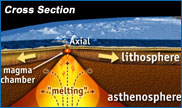 |
On the bottom of the ocean a giant crack is opening in the seafloor, which runs around our planet like the seam on a baseball. As it opens new seafloor is made as lava oozes up to fill the gap and spill over the edge of the fissure. Cold seawater causes the lava to rapidly cool, and eventually the crack splits again as the giant crack continues to open. Over and over the crack is filled and re-opened eventually making a wide area of new seafloor that is youngest near the center of the crack and older farther away from it (see images). The crack is called a rift and the constant filling of the widening crack is called seafloor spreading. Nearly all of the areas of Planet Earth under the oceans have been formed in this way. The rift lies at the crest of a submarine mountain range that snakes through all the oceans and is called the mid-ocean ridge system. Our study of the Lost City takes place near the rift in the mountains of the mid-ocean ridge, just about in the middle of the Atlantic Ocean. To understand how the Lost City formed and why it is so interesting to us, you have to understand a little about how mid-ocean ridges and seafloor spreading work.
With the seafloor growing like this you might expect that the Earth would have to be getting bigger, like an inflating balloon, but there is more to this story. As the seafloor spreads away from the rifts where it formed, it cools and becomes denser. This old, heavy seafloor sinks back down into the inside of the Earth at the deep sea trenches, the deepest places in the oceans. Under these giant ditches, the rocks of the seafloor are recycled. The recycling goes just about as fast as the spreading so that the Earth remains the same size. As it goes down, the old seafloor grinds against rocks above it and causes many earthquakes. It also triggers large explosive volcanoes. This sort of recycling is going on along the NW edge of North America and also many other places around the Pacific Ocean.